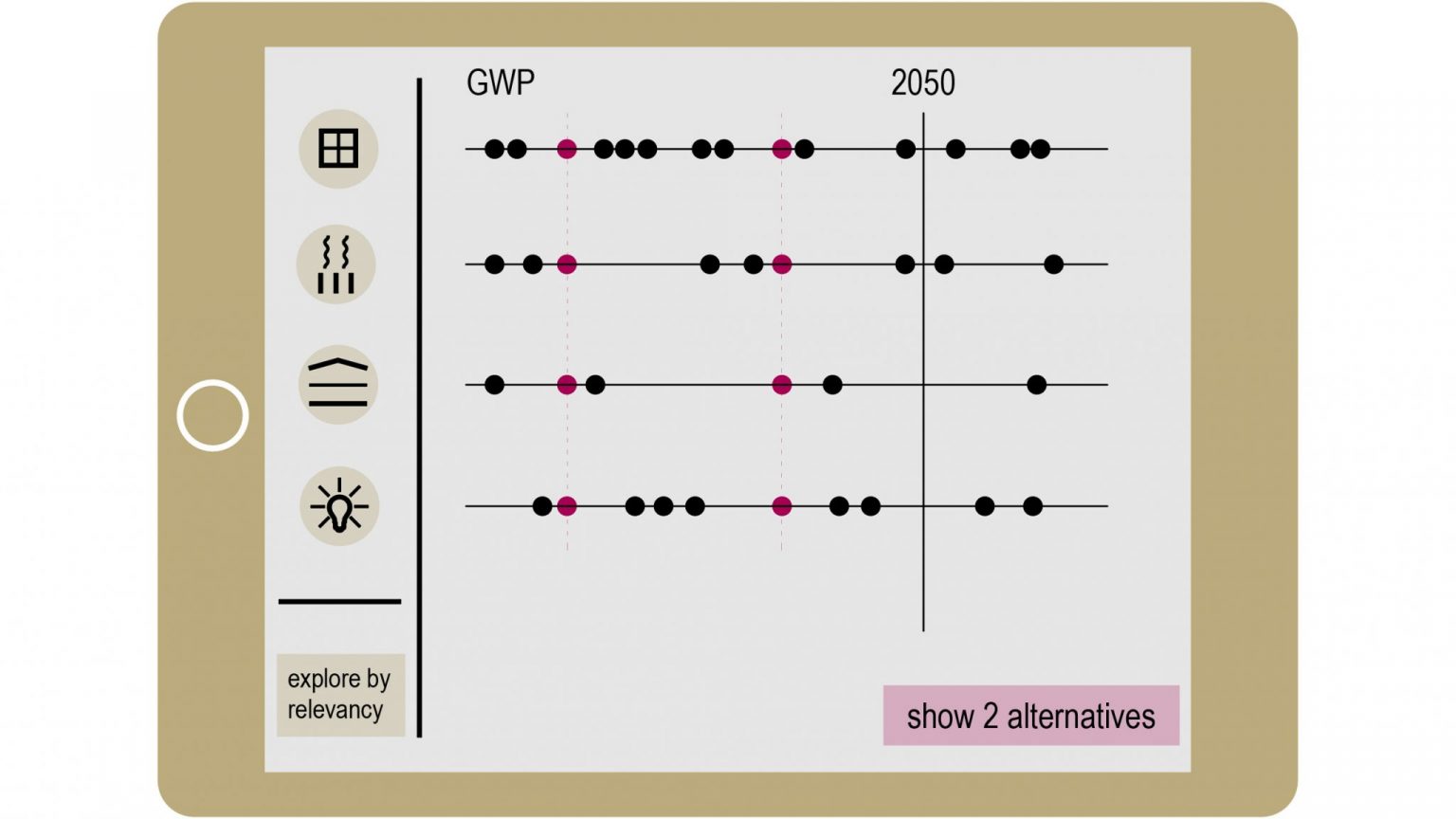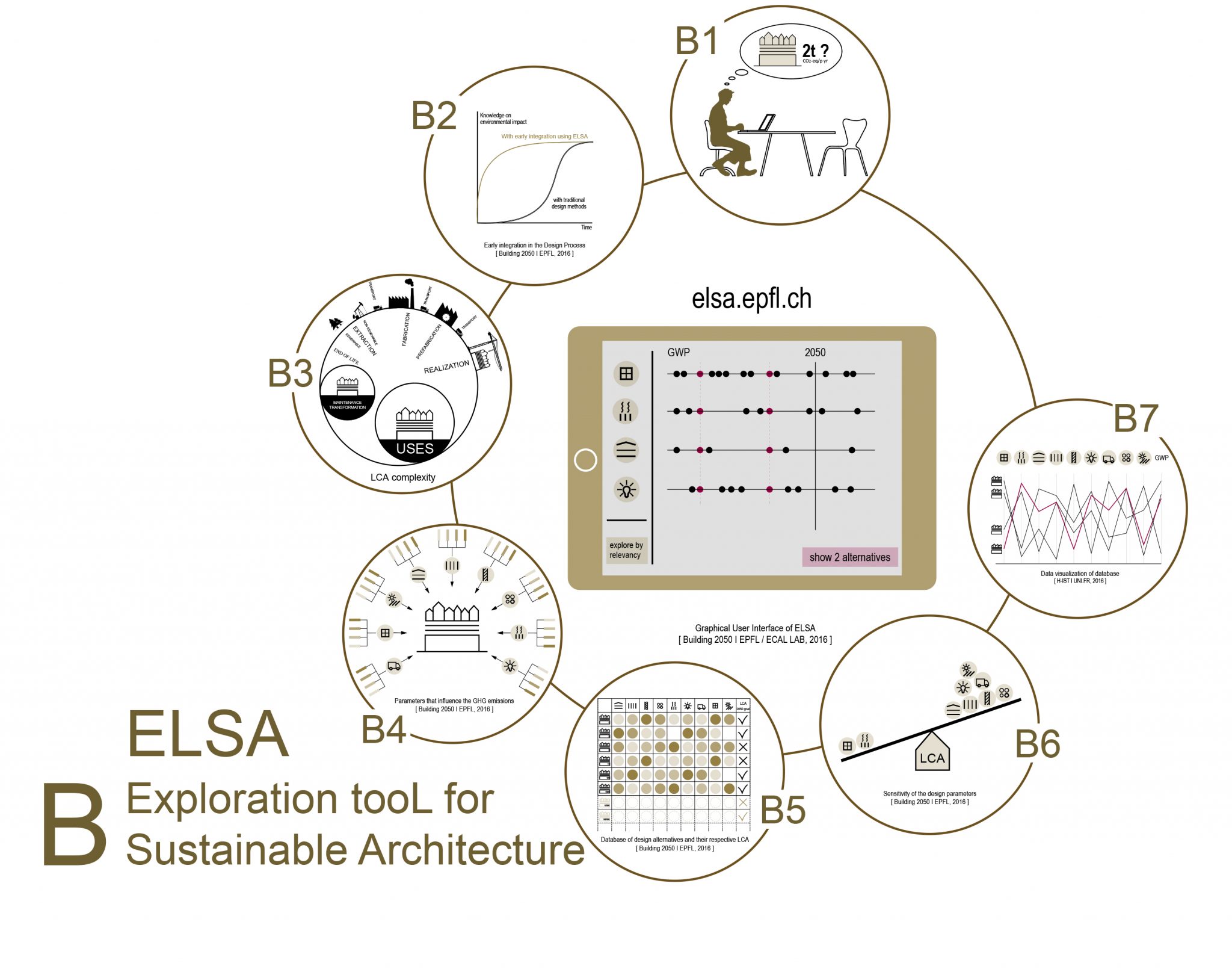Exploration tooL for Sustainable Architecture (ELSA)

On the basis of an architectural intention, it enables the designers to manage a limited “carbon and energy budget”, enforced for the building’s construction.
The tool uses a database of several thousands of conception alternatives, with their respective performances, allowing an early integration of environmental specifications in the design process.
Throughout the project’s materialization decisions, the incompatible options are eliminated, guiding the designer through his successive choices.
To face climate change, GHG emission targets will be set worldwide for the built environment, one of its major contributors. As a result, Life-Cycle Assessment (LCA) will become an important driver in the building design stakeholders’ decisions, for increasing the operating performance while minimizing embodied impacts. However, the integration of LCA to the design process adds a high degree of complexity (05-B3). In addition, it allows assessing the environmental
performance but does not help finding
design alternatives. New techniques such as design solutions exploration methods are promising tools to understand general performance trends, and to increase the usability of the results,but have not been applied to LCA so far. One of the challenges to face is that – due to the high number of parameters involved in GHG emission assessment in buildings – it is currently impossible to investigate all the design solutions in a reasonable computational time.
Adopted approach for the SLB research program on early stage LCA
A unique exploration method enabling to integrate lifecycle performance at early design stages has been developed through this research program and translated into an operating prototype named ELSA, which stands for Exploration tooL for Sustainable Architecture (elsa.epfl.ch).
This was made possible through an original combination of different techniques, developed towards this end: a variation of analytical target cascading methodology, which needed to be adapted to the building scale (01-D), parametric simulations (05-B4) and sensitivity analyses (05-B6). The proposed approach aims to appraise design alternatives instantaneously by highlighting the environmental consequences of architectural choices using specific data visualization techniques (05-B7).
For further details, see publications below
Partners
EPFL ECAL-Lab, EPFL
Human-IST, University of Fribourg
Funding
State of Fribourg – Switzerland
Please note that the publication lists from Infoscience integrated into the EPFL website, lab or people pages are frozen following the launch of the new version of platform. The owners of these pages are invited to recreate their publication list from Infoscience. For any assistance, please consult the Infoscience help or contact support.
Surveying the environmental life-cycle performance assessments: Practice and context at early building design stages
Sustainable Cities and Society. 2020-01-01. Vol. 52, p. 101879. DOI : 10.1016/j.scs.2019.101879.A data-driven approach for lifecycle performance
EXPLORING / Research-driven Building Design. Towards 2050; Zürich: Park Books, 2019. p. 276.Design guidance from a Data-Driven LCA-Based Design method and tool prototype
2019. 16th International Conference of the “International Building Performance Simulation Association” (IBPSA) Building Simulation, Rome, Italy, September 2-4, 2019. p. 1334-1341. DOI : 10.26868/25222708.2019.210403.Findings from a survey on the current use of life-cycle assessment in building design
2018-12-10. PLEA 2018 – Smart and Healthy within the 2-degree Limit, Hong-Kong, December 10-12, 2018.Usability assessment of building performance simulation tools: a pilot study
2018-09-12. Second International Conference for Sustainable Design of the Built Environment – SDBE 2018, September 12-13, 2018.An integrative approach for embodied energy: Towards an LCA-based data-driven design method
Renewable and Sustainable Energy Reviews. 2018-02-27. Vol. 88, p. 123-132. DOI : 10.1016/j.rser.2018.02.036.Energy efficiency trends in European buildings
CEPT University, Ahmedabad, 2018-12-19.Integrating hourly life-cycle energy and carbon emissions of energy supply in buildings
Sustainable Cities and Society. 2018-08-29. num. 43, p. 305-316. DOI : 10.1016/j.scs.2018.08.026.Visualization techniques for heterogeneous and multidimensional simulated building performance data sets
2017. SDBE 2017 – International Conference for Sustainable Design of the Built Environment, London – UK, December 20-21, 2017. p. 971-982.Smart Living Building Research Program – Executive Summary
2017
Building 2050 – Scientific concept and transition to the experimental phase
2016
Graphical representation of the smart living building research program
Building2050 Scientific Workshop, Gruyères, Switzerland, October 2016.Towards a pre-design method for low carbon architectural strategies
2016. PLEA2016, Los Angeles, USA, July 11-13, 2016.Building 2050 – Research program
2015-03-06
Building 2050 – State-of-the-arts and preliminary guidelines
2015
